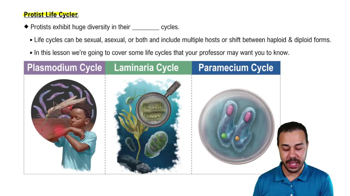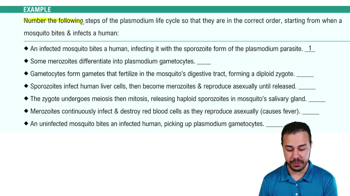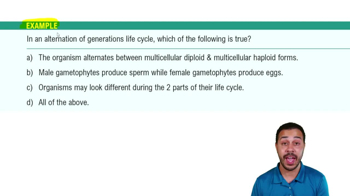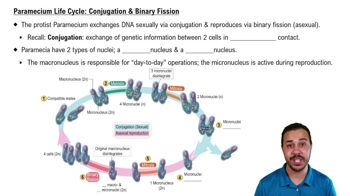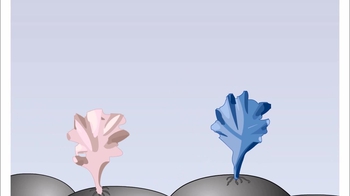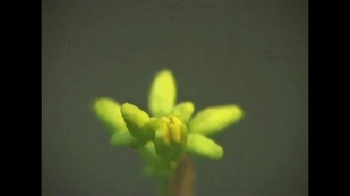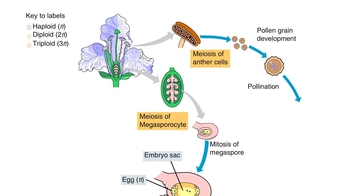Hi. In this video, we're going to look at a few ways that eukaryotic life cycles can play out. We'll see these ideas come up again when we take a look at the various lineages of protists, and also when we look at plants and animals, as well as fungi, later on. Now, we've already talked about alternation of generations briefly when we were talking about sexual life cycles, and we mentioned alternation of generations in connection to plants, but it actually plays out in protists as well. And basically, the way that alternation of generations works is that, in the course of the life cycle of these organisms, there will be a haploid and diploid stage and both of these will be multicellular or will have a multicellular component, I should say. So, looking at our image here, you can see here we have our haploid phase, and down here we have our diploid phase. Now, the haploid multicellular stage is known as the gametophyte. And you can see we have our gametophytes right here, and these are going to produce our gametes. Our gametes will get together and fertilization occurs, and we form a zygote. Now, the zygote will undergo mitosis and form the sporophyte. Right? The sporophyte is the diploid multicellular stage, and this is what is going to undergo meiosis and produce spores. Spores are a unit of asexual reproduction. They're generally haploid and unicellular. And we'll see that sporophytes are going to produce spores. These spores will undergo mitosis to form those gametophytes that we started off talking about. And of course, those gametophytes will then produce gametes and the cycle continues and we continually alternate between generations, the gametophyte and the sporophyte generation. So, we'll see this again when we talk about various protists and also when we talk about plants. Now what's kind of cool about alternation of generations is in some species, the sporophyte and gametophyte are structurally different. They look different, you know, they have distinctly different structures and we call these heteromorphic, basically meaning different shape. Right? Different form. Now in some species, the sporophyte and gametophyte will actually look the same. Even though, of course, in the sporophyte, the cells are all diploid, and in the gametophyte, the cells are all haploid. Pretty crazy, I know. These organisms are called isomorphic or same form. Pretty cool and you can see here we have two images. Both of these are actually brown algae. So these are both protists, both types of brown algae. This one over here is isomorphic though. So both the sporophyte and gametophyte are going to look like that, and this one over here is heteromorphic. And, this is a different type of brown algae. You don't really need to worry about the names or anything about these types of brown algae. Just an example of how two organisms that are from sort of the same lineage. Right? These are both types of brown algae. How they can use these two different types of strategies. With that, let's flip the page.
Table of contents
- 1. Introduction to Biology2h 40m
- 2. Chemistry3h 40m
- 3. Water1h 26m
- 4. Biomolecules2h 23m
- 5. Cell Components2h 26m
- 6. The Membrane2h 31m
- 7. Energy and Metabolism2h 0m
- 8. Respiration2h 40m
- 9. Photosynthesis2h 49m
- 10. Cell Signaling59m
- 11. Cell Division2h 47m
- 12. Meiosis2h 0m
- 13. Mendelian Genetics4h 41m
- Introduction to Mendel's Experiments7m
- Genotype vs. Phenotype17m
- Punnett Squares13m
- Mendel's Experiments26m
- Mendel's Laws18m
- Monohybrid Crosses16m
- Test Crosses14m
- Dihybrid Crosses20m
- Punnett Square Probability26m
- Incomplete Dominance vs. Codominance20m
- Epistasis7m
- Non-Mendelian Genetics12m
- Pedigrees6m
- Autosomal Inheritance21m
- Sex-Linked Inheritance43m
- X-Inactivation9m
- 14. DNA Synthesis2h 27m
- 15. Gene Expression3h 20m
- 16. Regulation of Expression3h 31m
- Introduction to Regulation of Gene Expression13m
- Prokaryotic Gene Regulation via Operons27m
- The Lac Operon21m
- Glucose's Impact on Lac Operon25m
- The Trp Operon20m
- Review of the Lac Operon & Trp Operon11m
- Introduction to Eukaryotic Gene Regulation9m
- Eukaryotic Chromatin Modifications16m
- Eukaryotic Transcriptional Control22m
- Eukaryotic Post-Transcriptional Regulation28m
- Eukaryotic Post-Translational Regulation13m
- 17. Viruses37m
- 18. Biotechnology2h 58m
- 19. Genomics17m
- 20. Development1h 5m
- 21. Evolution3h 1m
- 22. Evolution of Populations3h 52m
- 23. Speciation1h 37m
- 24. History of Life on Earth2h 6m
- 25. Phylogeny2h 31m
- 26. Prokaryotes4h 59m
- 27. Protists1h 12m
- 28. Plants1h 22m
- 29. Fungi36m
- 30. Overview of Animals34m
- 31. Invertebrates1h 2m
- 32. Vertebrates50m
- 33. Plant Anatomy1h 3m
- 34. Vascular Plant Transport2m
- 35. Soil37m
- 36. Plant Reproduction47m
- 37. Plant Sensation and Response1h 9m
- 38. Animal Form and Function1h 19m
- 39. Digestive System10m
- 40. Circulatory System1h 57m
- 41. Immune System1h 12m
- 42. Osmoregulation and Excretion50m
- 43. Endocrine System4m
- 44. Animal Reproduction2m
- 45. Nervous System55m
- 46. Sensory Systems46m
- 47. Muscle Systems23m
- 48. Ecology3h 11m
- Introduction to Ecology20m
- Biogeography14m
- Earth's Climate Patterns50m
- Introduction to Terrestrial Biomes10m
- Terrestrial Biomes: Near Equator13m
- Terrestrial Biomes: Temperate Regions10m
- Terrestrial Biomes: Northern Regions15m
- Introduction to Aquatic Biomes27m
- Freshwater Aquatic Biomes14m
- Marine Aquatic Biomes13m
- 49. Animal Behavior28m
- 50. Population Ecology3h 41m
- Introduction to Population Ecology28m
- Population Sampling Methods23m
- Life History12m
- Population Demography17m
- Factors Limiting Population Growth14m
- Introduction to Population Growth Models22m
- Linear Population Growth6m
- Exponential Population Growth29m
- Logistic Population Growth32m
- r/K Selection10m
- The Human Population22m
- 51. Community Ecology2h 46m
- Introduction to Community Ecology2m
- Introduction to Community Interactions9m
- Community Interactions: Competition (-/-)38m
- Community Interactions: Exploitation (+/-)23m
- Community Interactions: Mutualism (+/+) & Commensalism (+/0)9m
- Community Structure35m
- Community Dynamics26m
- Geographic Impact on Communities21m
- 52. Ecosystems2h 36m
- 53. Conservation Biology24m
27. Protists
Protist Life Cycles
Video duration:
4mPlay a video:
Related Videos
Related Practice



